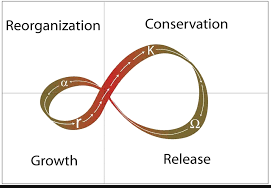a conceptual model that describes the ways in which complex-systems of people and nature are dynamically organized and structured across scales of space and time.
Named with the greek god pan in mind.
The panarchy model involves four phases that cycle through different types of change.
- Reorganization (alpha)
- Grows (r)
- Conservation (K)
- Release (omega)

The K-phase is characterized by more tightly connected couplings and centralized relationships that increase systemic fragility. If the system seeks to stabilize by tightening couplings and increasing centralized response—in other words, by ramping up the same strategies, a threshold can be breached where catastrophic collapse is inevitable. The panarchy model suggests that resilient systems must move into a phase of “creative destruction” before the threshold is breached. This is a phase of release where the stored energy is redistributed in a system that undergoes revitalization through the making of new relationships and creation of new identities and niches. New ways of living and world-building emerge.
This “release” phase of the panarchy cycle has been called the “back loop” (Wakefield, 2020, Chandler, 2020) and Holling himself has identified the Anthropocene as “a very big back loop.” Here all explanations break down. Here we should expect explanations to breakdown.
Resilience designs thus work in conjunction with front loop infrastructures, which continue to produce the disasters resilience intervenes on.
Back loop dynamics defy front-loop logics of planning, entanglement, strong couplings and instrumental acts upon which global resilience responses rely.
The logics of the back loop, include surprise, autonomy, loose couplings and random acts.